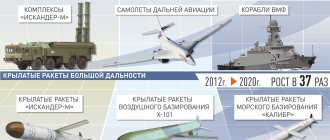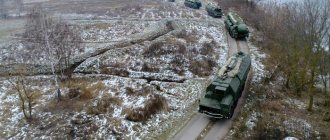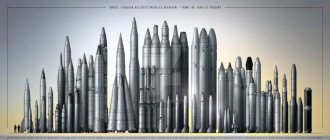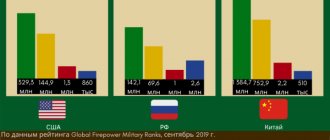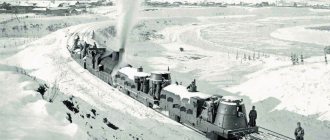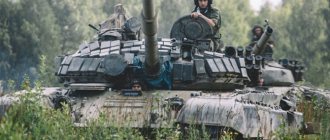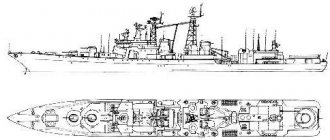Ballistic missile "Sarmat"
Photo source: Military Review
This intercontinental ballistic missile has not yet entered combat duty, but has already managed to cause concern abroad. It should go into operation in 2022 and replace the world's heaviest silo-based missiles, the Voyevoda, nicknamed "Satan" by NATO. Unlike its predecessor, the Sarmat will carry lighter charges, but with a greater guarantee of hitting the target. One carrier is designed to deliver from 10 to 16 guided warheads and release them along trajectories that significantly complicate interception by missile defense systems. Moreover, a range of 18 thousand kilometers allows one to bypass such means by plotting a suborbital flight route through the Earth’s poles. The missile can also carry non-nuclear warheads, which will allow it to be used in local conflicts. Also, due to the hypersonic speed and controllability of warheads, it will be possible to hit moving ships. The US estimates that its ships' defenses will not be sufficient to prevent a hit.
Tsar Cannon. 1586
The Tsar Cannon is one of the main tourist attractions in Moscow.
Cast in bronze in 1586 by Russian master Andrei Chokhov. Its weight is 39.3 tons. The barrel diameter is 120 cm. It is included in the Guinness Book of Records as the largest caliber gun—890 mm—for firing stone cannonballs. (The cast iron cannonballs weighing 1.93 tons that lie next to it in the Kremlin are decorative.) Theoretically, the Tsar Cannon is capable of firing stone “shot” with a total weight of 800 kg. However, examinations of the barrel showed that not a single shot was ever fired from it. It was a kind of “psychological weapon.”
Tank "Armata"
The T-14 Armata tank was created on the basis of the universal tracked platform of the same name. It is equipped with an uninhabited tower and numerous defenses. The manufacturer assures that it is impossible to penetrate the frontal metal-ceramic armor with existing anti-tank weapons. To protect more vulnerable areas, active armor with its own radar is used. It will be able to intercept even high-speed anti-tank shells, and the probability of being hit by grenade launchers will be no more than 5%. All this is thanks to metal plates fired towards approaching targets. Stealth technology reduces the detection radius of anti-tank systems by almost three times. The vehicle is intended to be used for missile and aircraft guidance. To do this, she has a radar, a drone with an autonomous radar, and global communications via the “army Internet.” At the moment, 20 pre-production copies of the T-14 have been created. The start of full-scale production and deliveries to the troops is planned for 2022.
Sturmovik IL-2. 1939
Il-2 is the most produced combat aircraft in the history of aviation.
A total of 36,000 of these cars were produced. The armor was part of its power structure, for which this aircraft was called a “winged tank.” Why was it produced in such quantities? Without the IL-2, conducting successful ground combat operations during the Great Patriotic War was impossible, whether it concerned defense or offensive. This role is eloquently illustrated by the nicknames that the Germans gave the attack aircraft: “black death”, “plague”, “meat grinder”.
Submarine "Lada"
Photo source: Military Review
Project 677 "Lada" - diesel-electric submarines for inland seas. In particular, they are planned to be supplied to the Black Sea and Baltic fleets. The submarine with a displacement of 1.8 tons is designed to destroy surface and underwater vessels. For this purpose, it is equipped with six torpedo tubes. The ammunition capacity is 18 torpedoes. In addition, there are launchers for Caliber missiles. The crew is 36 people. They can spend up to 45 days in autonomous navigation. The new vessels have used a number of technical solutions to reduce visibility. Thus, the body is covered with a modern anti-hydrolocation coating. A propeller with permanent magnets makes less noise than a classic propeller with asynchronous ones. Units subject to vibration are installed on special supports that absorb vibrations. The body, made according to a new design, has also been reduced. Its length is 66.8 meters, width - 7.1. The dive time has also become shorter. The first two submarines will enter service in 2022.
Kalashnikov assault rifle. 1947
The Kalashnikov assault rifle (AK) is not only the most famous Russian weapon, but also the most famous domestic brand.
The enormous “popularity” of the AK is associated with its reliability and ease of production. The USSR granted licenses for the production of these weapons to 18 countries. Another 12 countries “cloned” AKs without permission. The number of states that produced it “underground” cannot be counted. According to rough estimates, more than 100 million AKs have been produced worldwide. For comparison: the closest competitor, the American M16 automatic rifle, was produced in only 8 million copies.
Iskander missile system
Photo source: Military Review
The Iskander missile system, which is in service with the Russian Army, is primarily designed to overcome missile and air defense and destroy its elements. In addition, it can hit troop concentrations, warehouses, bridges and other strategic objects. The self-propelled launcher is capable of traveling up to a thousand kilometers on one refueling. She carries two rockets. Depending on the modification, two types of ammunition are used. Option “M” uses super-maneuverable missiles capable of rising to a height of up to 50 kilometers, dropping electronic warfare units and traveling to the target almost along a ballistic trajectory at a range of 500 kilometers. The complex with the index “K” carries a fundamentally different missile. It moves at a height of 5–7 meters above the surface, skirting the terrain. The stated range is 500 kilometers, but, according to US analysts, in practice it is at least four times higher. The figure is underestimated to avoid accusations of violating the Intermediate-Range Nuclear Forces Treaty.
RPG-7 grenade launcher. 1961
The RPG-7 hand-held anti-tank grenade launcher is considered the most effective weapon in history in terms of the ratio of its own cost to the price of the equipment being destroyed.
After a few minutes of instruction, an infantryman with a metal pipe on his shoulder and four cumulative grenades in his backpack has the firepower to stop a tank column. More than half of the losses of American army equipment in Iraq were caused by RPG-7s. And during the Vietnam War, 128 American helicopters were shot down with this weapon. In total, about 9 million copies of the RPG-7 were produced. His “clone” was even released in the USA.
Su-35 fighter
This is a deep modernization of the Su-27 aircraft. The Su-35 differs from its predecessor in a modified airframe and improved engines. To increase maneuverability, the nozzles can be deflected up and down. The armament consists of a 30 mm automatic cannon with 150 rounds of ammunition and 12 ammunition mounting points. The multirole fighter can carry unguided missiles, various air-to-air and air-to-surface homing missiles, anti-ship missiles and precision guided bombs. The radar is capable of detecting an air target at a maximum distance of 450 kilometers. The range depends on the effective scattering area of the object - that is, on its ability to reflect radio rays. The speed of the aircraft near the ground is 1400 kilometers per hour. Range without external tanks is up to 3600 kilometers. The practical ceiling is 20 thousand meters. The aircraft is in service as the main fighter of the Russian Air Force. Also supplied to Indonesia and China.
Who? Where? When?
I am sure that the uselessness of divisions in the infantry, which has been fighting for many years and dying in the field and in the city, in various “Hot Spots”, has been proven by smart and competent specialists with large scientific titles and large shoulder straps. And I’m sure they proved this to everyone (except me) from the lieutenant to the marshal.. But what about the percentage of enemies destroyed!?
If 60-85 armed enemies out of 100 soldiers and officers of the German and Japanese aggressor were killed by the division at one time, then who will kill them without it!? After all, this living enemy, not killed by the division, will destroy you!?
What has been added to the army that allows you to kill 60-85 out of 100 enemies!? Cell phones!? Who actually conducted statistics on the combat uselessness of divisions!? And what revealed enemy of the people made the last decisive signature!?
By the way, who did they bother? Well, in that war, when everything was carried out on horses, and on damned low-powered lorries, the disappearance of the divisions would have been understandable. But that’s when they were! What about now? Well, who will it bother if you just attach it to an infantry fighting vehicle or armored personnel carrier and throw at least a couple of boxes of shells into the back? By using an improved muzzle brake, which will lighten the system, by using titanium and composites, and by removing the heavy and unnecessary (for a gun) shield, we can easily get a 500 kg division..
The worst thing is that if someone doctrinally assigned all the percentages of killing the enemy to a machine gun, a machine gun and a grenade launcher, or rather, she convinced the Russian dolts in boots and caps that this was possible.
But in fact, this automatically begins to actually kill your soldiers, since a confrontation of equal weapons has occurred!!! (bandits in cities now have all these weapons) But equal weapons of direct combat contact do not give you any advantage, even if you are a state army and they are “dirty and evil lumps.” And this percentage of those killed may just as easily turn against you in the future...
This is an extremely uncontrollable factor - a confrontation between equal weapons. Here the very ability to wield this weapon multiplied by the situation plays a role.. Remember how 300 Spartans held back hundreds of thousands of Persians!? But just Sword-on-Sword! Plus knowledge, like the same Afghans or Chechens, of the area.
There is a public that proves to me that the introduction of howitzers into the army that hit tens of kilometers makes the division unnecessary... And I can perfectly imagine any interaction of Russian “boys” in any spheres of life that are not just ten kilometers away, but a hundred, or two meters from each other..
And here the targeted operational shooting of the divisions should be replaced by the firing of terribly powerful howitzer shells using coordinates given on a mobile phone made in Malaysia and according to the coordinates of “Russian” maps made from some kind of pirated blanks (from an American satellite) and printed in Chukhonia.. I was born here after all, and I can imagine how it will turn out.
Do you seriously believe that a HOWBITTER battery will help a platoon (A squad?) of infantry that is fighting in some village?!
Although imagine for yourself that you need to ask a courageous and semi-smart battery commander unknown to you to fire a couple of shells into some house or a pile of stones where abreks with a machine gun are lying and this household bunker is not 5-8 kilometers away from you, but somewhere 200-400 meters from you. You take a Korean mobile phone and..
-Where do you think the guys with howitzers who are hanging around about ten kilometers from you will hit the first shell?! And these howitzers won’t even be able to shoot closer.
So instead of divisions, the infantry will help? Fire support helicopters you say!? Stormtroopers? I think that the homing unit will soon be inserted not only into the warhead of a missile from the very expensive (for Russia) “Stinger”, but also into any missile of any “fly”, or even not into a 14.5 mm bullet.. I'm sure the helicopters over the battle have already taken off...
If any “expert” with a confident ambition wants me, even in his opinion, to prove to the Tambov sucker that divisions are unnecessary in the army, then he will have to bring me tables of losses with their distribution by type of weapon used...
Although in the Second World War there was a precedent when they fought with equal (conditionally) weapons. Characteristic in this regard is Stalingrad and the battles in European cities. But! Already in Europe, the soldiers of the Red Army were accustomed, out of great need, to carry Katyusha rockets in their arms and launch them from painting goats. The divisions there rode through the streets, when necessary, rolling them over the debris in their arms and kissing them after the battle..
But the worst thing is not even that the infantry received only small arms for battle. The grave humor is that your infantry is armed with the worst small arms in the world which, in addition to this, uses the weakest service cartridge in the world..
**************************************************************************
The following material includes illustrations that I have on Yandex disk. This is a general set for the 1st book Aviation -
https://yadi.sk/d/Wy_pmclwbGtZn
and specifically drawings for the topic https://yadi.sk/i/cqs6dYIybGty3
and also https://yadi.sk/i/Iw-otSS7bGtyGand this - https://yadi.sk/i/pAFtuCVEbGtmE
Anti-aircraft missile system S-400
A mobile anti-aircraft missile system designed to destroy all types of air targets, including maneuvering ballistic missile warheads - including hypersonic ones at a speed of 17 thousand kilometers per hour. The complex's radar can detect the enemy at a distance of up to 600 kilometers. Hit - within a radius of 2 to 400 kilometers for aircraft and 60 kilometers for missiles. A distinctive feature is the ability to fly missiles over the surface while bending around the terrain, which makes it possible to destroy objects at an altitude of 5 meters (Western analogues intercept targets flying at least 60 meters). The S-400 can use three types of ammunition - depending on them, the maximum interception altitude ranges from 27 to 35 thousand meters. One complex is capable of simultaneously monitoring up to 10 targets and directing up to 20 previously fired missiles at them. Up to 8 complexes can be combined into a single control. When deployed, they can go from standby to firing in 36 seconds.
HK MP5
German-made submachine gun. Used by the FSB, often with a modified sight, and by other special forces. Weapons of this model have been produced since 1966, and in the 21st century remain popular in many countries of the world, not only in Russia.
The submachine gun has compact dimensions, a 22.5 cm long barrel, and is designed for 9 mm Parabellum cartridges. The rate of fire of the HK MP5 is 800 rounds per minute. With an aiming range, cartridges fly at a distance of 200 m, the magazine holds 30 cartridges. Among the advantages of the HK MP5 are its simple design and low recoil.
Su-34 bomber
This aircraft is primarily designed to destroy ground and surface targets. It operates unaccompanied by fighters, since its flight qualities allow it to conduct maneuverable air combat on a par with them. 12 hardpoints are designed for various types of guided and unguided air-to-surface missiles, as well as medium-range and close-range air-to-air missiles. In addition, there is an automatic cannon with a caliber of 30 millimeters and an ammunition capacity of 180 shells. Ground speed is 1,400 kilometers per hour, flight range without refueling is 4,500 kilometers, service ceiling is 14.6 thousand meters. The SU-34 is at least three times less noticeable on radar than most fighters. This allows it to be effectively used for reconnaissance purposes. For this purpose, special containers with equipment are hung. The crew of two people is located nearby. In case of long flights, behind the seats there is space to stand up, a dry closet and a microwave. The cabin is armored.
The most powerful firearm in the world
Firearms are constantly being improved and represent a great danger and destructive force in close combat. Shotguns, pistols and machine guns of the modern world are very different from those of the last century.
- MG4 light machine gun . The launch speed is 770 bullets per minute. And the destructive power is comparable to a bazooka;
- AK-47 . The most famous and reliable Kalashnikov assault rifle has claimed the lives of hundreds of thousands of people. Shot speed – 600 bullets per minute;
- Glock, 45G.AP The pistol has gained popularity in special forces. A lightweight, ergonomic and multi-functional pistol exceeds the Kalashnikov's power and is more comfortable to carry;
- Automatic HK416 A5 . The high-precision machine gun features a winter-type trigger. This allows the shooter to use the weapon while wearing gloves. In addition, the machine gun is adapted for shooting at night while maintaining a high-precision sight;
- Pistol DE50SRMMB . The undisputed leader in close combat. A person caught in the sights of such a pistol is doomed to death, since one bullet tears the body into tiny pieces. Damage incompatible with life predetermines this type of weapon as one of the most powerful;
- AS50 large caliber rifle . The power of the shot is comparable to the explosion of a grenade. Obviously, the large caliber, high accuracy, and most importantly, the stealth of this cool weapon has no analogues;
- Tracking Point Rifle . Automated weapons are equipped with a laser sight. In addition, the computer itself determines the time of a successful shot, taking into account the parameters of wind strength and distance to the target.
Finally, I would like to note that since the end of the Cold War, Russia has only been increasing its non-nuclear weapons potential, which worries the West and America.
Large landing ships of the Russian Navy project 775
Large landing ships, due to their shallow draft and flat bottom, can land infantry, equipment and cargo in unequipped areas of the coast - in particular, on the beaches. If the depth is too shallow to get close to the shore, they can open the front ramp even in the sea with waves up to 4 points. In these cases, amphibious equipment is deployed. The length of such vessels is 112.5 meters, the maximum width is 15. Equipment is loaded from the pier through the rear ramp, and disembarked through the front. The tank hold stretches along the entire length of the hull. There are several loading options - for example, 13 main medium tanks or 10 tanks and 340 people, and so on. In addition, 150 marines from the personnel constantly serve on the ship. The ship can fire at coastal fortifications using two 122-millimeter Grad rocket launchers with an ammunition load of 320 missiles. To combat surface ships there are 57-caliber automatic cannons, and against aircraft there is a six-barreled 30-caliber cannon.
Tornado
The most formidable weapon is a type of rocket launcher, the ancestor of which is considered to be the world-famous Katyusha. An effective missile system requires 3 minutes of preparation and 38 seconds to fire a salvo. The destructive force demolishes modern battle tanks. Moreover, it is possible to start the salvo process remotely using a remote control.
The tornado exhibits enviable performance in any climate zone, fearing neither extreme heat nor cold. The disadvantages of a rocket launcher include the indiscriminate area of destruction. The area of destruction will make it possible to stop an entire artillery. The manufacturer of Smerch is the Russian Federation. Currently, 13 states are purchasing missile systems at a cost of about $12.5 million.
Non-nuclear Kilo class submarines
Kilo is the NATO classification adopted for diesel-electric submarines of projects 877 and 636. The first was developed in the 1970s, the second is a later modification and is currently in operation. The design turned out to be so successful that boats of this class with various modifications are still being built. In addition, they were exported to Algeria, Vietnam and China. They are designed to destroy surface and underwater vessels. The armament includes 6 torpedo tubes, with a total ammunition capacity of 18 torpedoes. It is possible to use devices for installing sea mines; instead of torpedoes, you can take 24 of them. There are also Caliber-type missile systems. The latest modifications (project 636.3), being built for the Russian fleets, are equipped with the latest radar equipment - in combination with a low noise level, it allows you to detect targets without giving away your presence. Also, such submarines received the latest generation navigation system and a modern automated weapons control system.
Borei class submarines
Nuclear submarine cruisers of Russian design. The length is 170 meters, width - 13.5. The crew consists of 107 people, 55 of whom are officers. Displacement on the surface and underwater is 14,720 and 24,000 tons, respectively. Underwater, the ship reaches a speed of 29 knots. By comparison, the speed of surface combatants rarely exceeds 31 knots, and most have less. The body has a rubberized coating to absorb sonar waves, and there are also active means to prevent detection. To reduce noise, all units are installed on anti-vibration stands. The target search complex is superior in range to analogues installed on American Virginia-class boats. The submarine is equipped with six torpedo tubes. But its main armament is 16 Bulava ballistic missiles. They can be launched from an underwater position and deliver from 6 to 10 self-guided warheads with nuclear warheads to a distance of up to 9,300 kilometers.
Guards rocket mortar "Katyusha". 1939
Guards mortar - this is what the multiple launch rocket systems were called for reasons of secrecy, to which the name “Katyusha” was assigned during the Great Patriotic War.
The effect of this weapon was a colossal concentration of firepower: the BM-13 installation fired 16 shells in 7–10 seconds. Not only the warheads of the 42.3-kilogram shells exploded, but also the hot housings of the rocket engines.
As a result, the addition of many blast waves was enhanced by the ignition effect, which gave rise to the legend of the Katyusha thermite charge. The Germans, who called this weapon “Stalin’s organ,” noted cases of madness among their soldiers after shelling with Katyushas.

